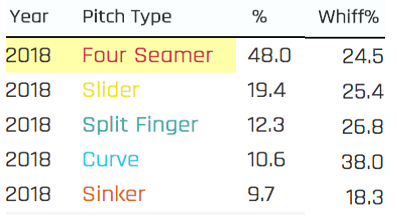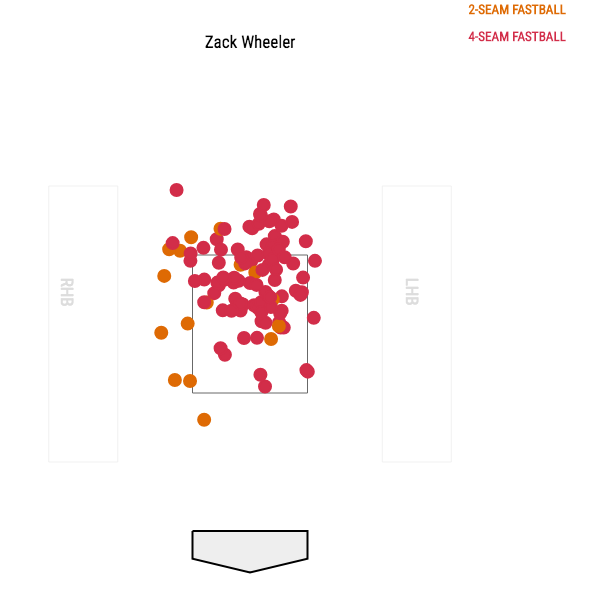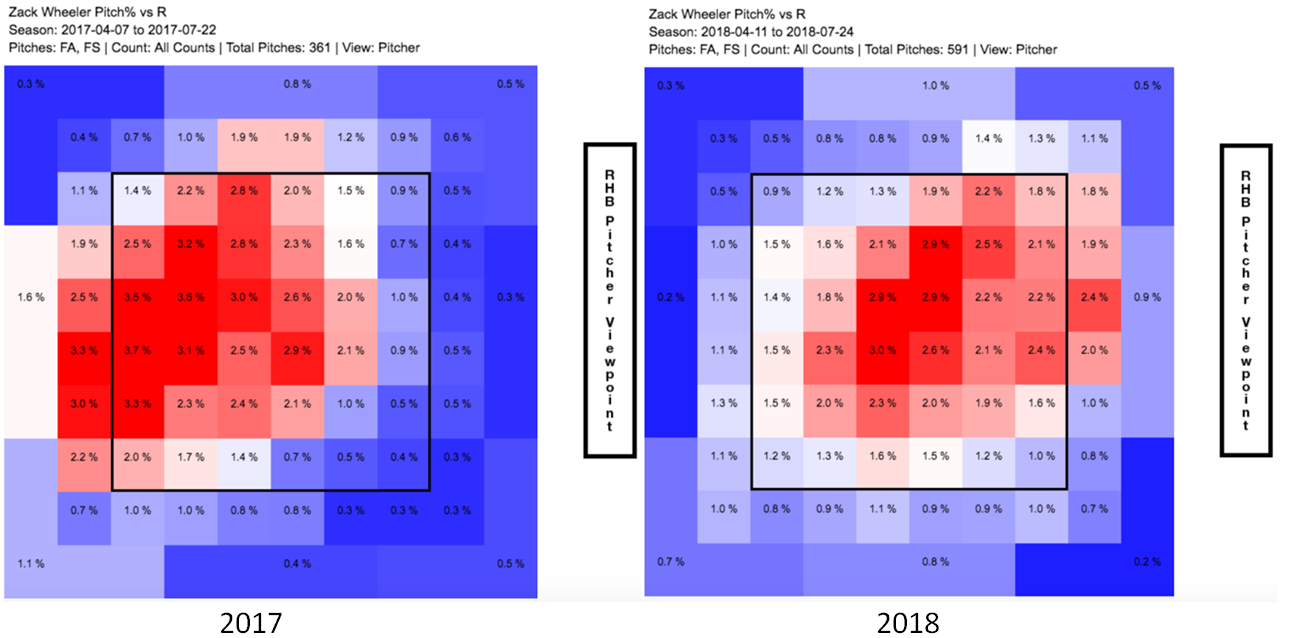This article is a Community Post written by guest contributor Dan McNamara. If you’re interested in writing a guest piece at Pitcher List, send us an email at Community@PitcherList.com
As fantasy baseball players, we often get caught up in eye-popping performances or statistics. We seek to understand if something amazing is sustainable or if something horrific will ever reverse its fortune. These journeys are often fun, as they open our eyes to either extreme flaws or exciting talents, and we can latch onto certain things and boldly project the future of the players in question. Spoiler Alert: this is not that kind of journey.
Nope… this is one of confusion, fascination, and hope, and Zack Wheeler is our focus.
Zack has slowly made his way from top ten overall draft pick, to member of the most hyped rotation in recent memory, to Tommy John victim, to guy being debated as an occasional streamer in most leagues. We’ve seen brilliance and blowups, but on the bottom line, we’ve seen a pretty boring pitcher. I mean, what is a “Zack Wheeler”? Well, here are the career numbers:
| ERA | FIP | xFIP | WHIP | K% | BB% |
| 3.95 | 3.94 | 3.91 | 1.37 | 22.1 | 9.8 |
Yup, he is who he is. And. It. Is. Boring. Usable? Sure. Attractive? Not really.
What’s your point, Dan? Yo, relax.
My point is that Wheeler appears to be the definition of mediocrity on the surface. So what is it about him that has allowed him to flash brilliance over multiple stretches in his career that gives us hope for the “6th overall pick” pedigree to finally stick? Well, there are a few things that you’ll find out about Zack Wheeler if you take a peek under the hood.
#1. He keeps the ball on the ground and in the yard
We all love our groundball pitchers. The damage-minimizers, the home-run-suppressors, the weak-contact-inducers. Zack Wheeler has been one of these guys for a while now, with a 48.3% groundball rate for his career. In 2014, which was his best (and only full) season, he induced groundballs at a 54.0% clip and accompanied that with a 0.68 HR/9. That was good for 9th and 24th best respectively among qualified starters and certainly played a huge role in his solid 3.54 ERA.
After a really rough return from Tommy John in 2017, where he gave up a whopping 1.56 HR/9 to go along with his reduced strikeout rate and elevated walk rate, in 2018, Wheeler has turned in a 0.82 HR/9 that is more than acceptable in this current hitting environment along with a still very acceptable 43.6% groundball rate. We would certainly love to see that groundball rate rise a bit, but when you combine Wheeler’s current profile with his next skill, we can see how he’s continued to minimize damage and find some success.
#2. He Induces Weak Contact
Wheeler is really good at this. In fact, of the 144 pitchers with at least 1000 pitches thrown this season, he ranks 5th in average exit velocity at a mere 84.8mph. Combining that with his groundball tendencies and above average 9.5° launch angle, it’s clear that Zack has developed a really nice ability to miss more barrels (8.7% barrel rate in 2017, 5.8% in 2018) and suppress hard contact. I think we can all agree that’s a nice combination, and it’s this weak contact that makes the dip in groundballs in 2018 more acceptable, because even as more balls are getting airborne, they aren’t being struck well enough to punish Wheeler.
Dan, where are you going with this? Dude, I’m getting to it, chill.
I really am by the way, because this is where the weirdness of Zack Wheeler really starts.
#3. He’s Actually Got Good Stuff
**Quick preface: I will be referencing both “Swinging-strike rate” and “Whiff Rate” in this next segment. To those who are not familiar with the distinction, here it is:
SwStr% = Swings-and-Miss/Pitch
Whiff% = Swing-And-Miss/Swing
One thing that Wheeler has never really had is a great swinging-strike rate, as he’s always hovered between 9-10% during his time in the majors. In 2018, he’s finally made a significant leap all the way to 10.9%, but that being said, his route to those whiffs is certainly unorthodox.
If I were to describe Wheeler’s repertoire, I’d say it’s something along the lines of… remarkably solid. There are no pitches that stand out, but every pitch is… good? I don’t know, it’s weird. Allow me to illustrate.
| 2018 | O-Swing % | Zone % | SwStr % | pVal/C |
| Fourseam | 29.0 | 57.1 | 10.1 | 0.7 |
| Slider | 31.1 | 39.2 | 11.2 | 0.9 |
| Curveball | 28.2 | 40.9 | 13.1 | -0.1 |
| Changeup | 42.7 | 33.1 | 12.3 | -0.2 |
| Splitter | 45.1 | 23.9 | 14.9 | 1.0 |
Yup, according to Fangraphs, Wheeler has five (FIVE!) pitches that have a double-digit swinging-strike rate. I don’t have the numbers in front of me, but I’m going to go out on a limb and say that he is either the only or one of VERY few pitchers in baseball who can claim that.
I chose these particular rate statistics because they are the parameters that help identify an important entity in the Pitcher List Community: the Money Pitch.
Nick Pollack coined this term himself and defined it as any pitch with a 40% O-Swing, 40% Zone, and 15% SwStr. In other words, a pitch that is deceptive enough to induce a lot of chasing, thrown in the zone enough to warrant protecting the zone as a hitter, and filthy to the point that we can assume that the pitch is either achieving an astonishing whiff rate when chased or getting a high percentage of swings and misses even when thrown in the zone.
Max Scherzer’s slider, Justin Verlander’s curveball, Aaron Nola’s curveball, Chris Sale’s changeup. These are all examples of tremendous money pitches. As you can see from above, Zack Wheeler not only doesn’t have a money pitch, but isn’t even CLOSE to having a money pitch.
But you said he had good stuff! Re. Lax. He does. Let me explain.
His slider has taken a step back this season in its O-Swing and, in turn, its swinging-strike rate (previous career low was 13.1%), but Wheeler appears to be using it for a different purpose in 2018. Of the 60 pitchers who have had at least 50 sliders put in play this season, Wheeler’s 60.3% groundball rate on those sliders ranks 2nd in the majors behind only Clayton Kershaw. Combined with a still solid 11.2% swinging-strike rate, it’s no wonder his slider has an excellent 0.9 pVal/C.
So where are the other swings and misses coming from? Well, he has pretty good swinging-strike rates on his curveball, changeup, and splitter, but none of them stand out in an eye-popping way that would resemble a truly dependable put-away pitch.
Are you kidding me with this—… HOWEVER…
… if we pivot to a few different metrics, we can clarify a couple of things and gain a bit more insight into Wheeler’s execution and repertoire.

The above chart comes from Baseball Savant’s Statcast data for Wheeler. As you can see, no changeup. My educated guess based on the usage in both Fangraphs and Baseball Savant view the changeup and splitter as the same pitch. Knowing that, we now have a pitch with a still impressive mid-40s O-Swing, but a slightly less impressive 13% swinging-strike rate. Still nice, but… still not anything special.
However, let’s take a look at that curveball. Even though it only has a 13.1% swinging-strike rate, it has an extremely impressive 37% whiff rate. So when Wheeler gets hitters to swing, he’s fooling them more than a third of the time. That is dominant. Additionally, his curveball has only a .205 AVG/.308 SLG against and a miniscule .188 xAVG/.241 xSLG against, yet, oddly enough, it also has negative pVal. So clearly Wheeler is not getting the most out of a pitch that is showing significant promise. And if we lump all fastballs into a single category and abide by the splitter/changeup same-pitch theory, he’s also throwing the curveball the least of his entire arsenal.
I won’t pretend that simply increasing the usage of a good pitch results in automatic improvement, as the success of a pitcher comes from the way he deploys his pitch mix to keep hitters off-balance, but all metrics are indicating that Wheeler should be relying more heavily on this pretty awesome curveball. Maybe he doesn’t trust that it’s as good as the numbers say it is? Or perhaps he just wants to keep relying on the last skill I’ll touch on, because it is a mark of a true ace…
…Zack Wheeler has an awesome fastball.
On a 57.1% zone rate, he’s getting a career-best 10.1% swinging-strikes with it. That, again, is a tremendous number. Allow me to share the top ten pitchers in baseball in terms of fastball swinging-strike rate with at least 750 fastballs thrown.
| Max Scherzer | 15.5% |
| James Paxton | 13.8% |
| Chris Sale | 13.7% |
| Jacob Degrom | 13.7% |
| Justin Verlander | 13.1% |
| Gerrit Cole | 12.8% |
| Vince Velasquez | 12.5% |
| Jake Odorizzi | 11.9% |
| Brent Suter | 10.7% |
| J.A. Happ | 10.3% |
As you can see, having a dominant fastball is something that many of the best pitchers in the game can claim, and Zack Wheeler would be next on this list at 11th. And Zack hasn’t achieved this by luck, but rather in style.

We love elevated four-seamers at Pitcher List, and Wheeler is clearly using them to get a lot of swings and misses in 2018. Combining this skill with his breaking balls that are clearly capable of getting whiffs, as well, there is no reason to doubt that Wheeler should be dominating more than he is… so why isn’t he?
Well… I don’t know.
WHAT?!?! AFTER ALL THAT??
A Hero Emerges…
Lucky for all of you who hung tough through this adventure, I was able to catch-up with one of our industry experts in the Pitcher List Community: the great Andrew Perpetua. Andrew is the Founder of xStats and a contributor for Rotographs and NEIFI (Normalized Empirical Individual Forecasting Index), which is a new system that doesn’t believe in solely data-mining as the root of player projections, but rather, according to their website, “carefully codifying, refining, and systematizing the thought processes involved in player evaluation”. That approach is exactly what we need in order to connect the various dots we’ve discovered during our research on Mr. Wheeler, and conveniently enough for me, Andrew is not only a brilliant mind, but also a lifelong Mets fan who has seen almost every Zack Wheeler start over the course of his career.
I definitely went into my conversation with Andrew as a bit of pest, throwing masses of data at him to counter all of his initial claims about Zack. He claimed that Wheeler doesn’t elevate his fastball, exhibits too much predictability with his curveball, doesn’t throw below the zone, and, most crucially, has “bad location”. It took me no time at all to go find the charts to disprove those statements on the surface, but Andrew continued to calmly insist that Wheeler’s location was bad. It was our next exchange that finally put us on the same page:
Me: “So, what? You’re saying he doesn’t trust his stuff?”
Andrew: “I’m saying he doesn’t trust his command.”
Ah… command. The fox of a skillset that the statistical hounds in our industry are yet to catch. We can see results – even good results – but does that mean that they stemmed from the pitcher executing how he wanted to? Andrew described Wheeler’s approach very succinctly: “10% of his problems are from the simple fact that he has really bad command. And the other 90% [are] his fear and insecurities from knowing he has bad command.”
Andrew would then elaborate on the results of this fear.
“He’d pitch like a normal pitcher until he got one strike, then every subsequent pitch would be low and outside until he got to three balls. Then he’d throw a meatball fastball.”
“Wheeler does not triple up on fastballs to climb the ladder. He doesn’t bounce his breaking balls. He just doesn’t.”
We did not necessarily agree that Wheeler has “bad” command, because I believe that the effectiveness of his fastball and slider and the immense deception of his curveball suggests that the command is there for certain locations, but that still plays into Andrew’s observation of predictability and, in turn, bad location when he has to pitch outside of his comfort zone. We are seeing improvements this year though – a career-best walk rate, career-best contact skills – so he’s clearly doing some things differently, right? Andrew agrees.
“[…] did you see that new thing he’s doing between starts? He throws only glove side fastballs.”
“He never used to throw inside [to righties], but now, in between starts, he ONLY throws inside. And it’s been transferring to games.”
Andrew added that this isn’t just experimentation, but rather a result of mentorship within the organization.
“He’s trying to learn from deGrom. [deGrom] does all the stuff he doesn’t do. [He’s] the perfect player to learn from.”
“deGrom is a guy who climbs the ladder. He’ll throw one fastball at your belt, one at the letters, then one at your neck. And you’ll swing and miss at all three.”
This is all true.

These are the heatmaps for Wheeler’s fastball usage vs right-handed hitters in 2017 vs 2018 from the pitcher’s point of view. They clearly illustrate exactly what Andrew is calling out.
Additionally, this post from SNY highlights Wheeler giving credit to deGrom for teaching him how to more effectively and consistently pinpoint his fastball to the “glove side”; thus, opening up a whole new weapon to challenge hitters with. This is likely a major factor in the increased effectiveness of his fastball and a tool that has enabled him to start pitching deeper into games. All good things.
So, what do we think of Zack Wheeler?
Well, let’s summarize the man.
Vast, effective, and potentially lethal arsenal. Elite contact skills. Access to an elite mentor.
The Dark Knight is gone. He’s left Gotham and fled to Cincinnati. So the door has opened for a new hero to step forth.
But… Jacob deGrom is – LET ME HAVE THIS!!
Much like Bruce Wayne once believed in Harvey Dent, I believe in Zack Wheeler. I tend to be a broken record sometimes with this line, but this is yet a another scenario calling for its use: prospect growth is non-linear. Zack Wheeler has enough raw talent that scouts decided that he was worth a top ten selection in the 2009 draft. We’ve covered what he does well. We’ve covered what he does REALLY well. Most importantly, we’ve allowed stats and scouting to shake hands to provide a full picture of not only the results, but also the mindset of Zack Wheeler while he’s on the mound. If Zack can take his immense talent and continue to grow as an apprentice to Jacob deGrom, I believe that he not only becomes must-own in most leagues, but takes a leap toward the elite tier of starting pitchers.
He’s talented. He’s close. He’s the hero Gotham wants. Will he answer the call? Only time will tell.
